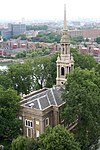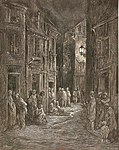Battle of Cable Street
1936 in London20th century in the London Borough of Tower HamletsAnti-fascism in the United KingdomAntisemitic attacks and incidents in EuropeBattles and conflicts without fatalities ... and 8 more
Fascism in EnglandOctober 1936 eventsPolitical riotsRace riots in EnglandRacially motivated violence in EnglandRiots and civil disorder in EnglandRiots in LondonUse British English from May 2015
The Battle of Cable Street was a series of clashes that took place at several locations in the inner East End, most notably Cable Street, on Sunday 4 October 1936. It was a clash between the Metropolitan Police, sent to protect a march by members of the British Union of Fascists led by Oswald Mosley, and various de jure and de facto anti-fascist demonstrators, including local trade unionists, communists, anarchists, British Jews and socialist groups. The anti-fascist counter-demonstration included both organised and unaffiliated participants.
Excerpt from the Wikipedia article Battle of Cable Street (License: CC BY-SA 3.0, Authors).Battle of Cable Street
Cable Street, London Shadwell
Geographical coordinates (GPS) Address Nearby Places Show on map
Geographical coordinates (GPS)
| Latitude | Longitude |
|---|---|
| N 51.5109 ° | E -0.0521 ° |
Address
Chamberlain House
Cable Street
E1W 3DP London, Shadwell
England, United Kingdom
Open on Google Maps








